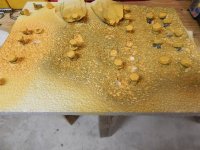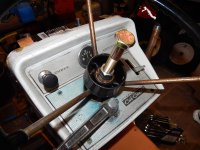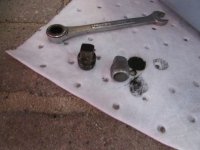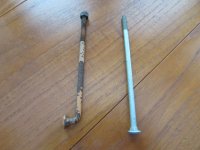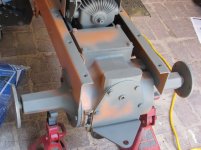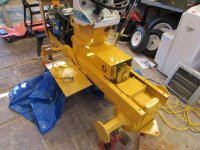daugen
Epic Contributor
not sure I understand why load testing the new battery will give me info, I did put it on a smart charger and it took very little to charge fully. Luckily on old machinery like this, unlike our current car/truck engine compartments, one can really see where everything goes. The wiring loom is very ok, for being 48 years old. I thought of replacing it, but you know, these old CC's were built like little IH tractors and the wiring reminds me of something much larger. Besides I can always replace the wiring loom later if need be. Now I just have to get it all out of the way to get the tractor painted. I don't like painting electrical wires; want to see what's going on "under there"....... If I were making this a show tractor, I'd fuss even more but at some point, even for a barn queen, one has to draw the line. Before I bought this thing for 500 bucks years ago, I ran it, the mower deck worked (off the machine and never to return, but I'll rehab it anyway) and it went forwards and backwards fine, so that hydrostatic trans seemed to work. So part of this is, if it works, don't muck with it....
I was missing one tiny 10/32-1/4 screw that holds the air cleaner base on. Napa, two stores didn't have anything smaller than half inch. So, why not try the Kubota dealer, they've been there a long time, and sure enough, in a yellow little parts bag, had been on their shelves for over 30 years, was one little genuine Kohler screw for $1.79. I sure took it and ordered another. So if someone takes off my air cleaner 100 years from now, they will surely be impressed by those genuine oem screws....
Kinda wondering if that wheel spinner had been outside for a while before it ever made it to this little garden tractor. I wonder if it's a collector's item, genuine solid aluminum spinner from the 50's or 60's. yeah, putting that screw into the steering wheel clearly showed one prior owner, I have no idea how many people have owned this before, was really a low class act. There will always be a rough spot there though I guess I can fill it in with some rubber/plastic repair kit. Actually, these whole wheels are available in the used market. The steering wheel will look nice once I get the spokes painted in shiny aluminum, or maybe fake chrome.
I've restored a Case IH 255 tractor, my Gravely 8199G and a variety of small equipment. Have learned a lot doing so, made a lot of mistakes, and am now properly careful about not painting on cold metal. Done that too many times, it never works well, puckers up. So I am a bit stymied with a unheated barn. Tried a 80k propane heater in there two days ago and it never got warm enough. I can take individual small parts into my woodshop which is heated just fine, but I never wanted paint spray in that room. So I have to be patient and I'll work on what I can until the weather warms up. Mid fifties during the days, very nice, but at nights it goes down to freezing so everything in the barn gets cold. Can't paint that....
There is a bit of play in the steering wheel. CC had a complicated bearing setup for the column and I'm not confident taking that column apart. There is an aftermarket kit from Kirk engineering that might help but honestly to pull a water cart here and there I'm sure what I have is fine. I did notice that Kirk has a new electronic ignition available. Even with the hybrid system I bought from them, which came with the bigger coil, can't seem to avoid sticking points. If this tractor sits for more than three weeks, in damp weather, the points stick. Sometimes I can bang on the points case and they will let loose, and then if I use the tractor often, like I do now pulling a water roller fixing truck ruts, the old KT19 starts up instantly. Very impressive even in cold weather. So there's plenty of juice in there, but the points remain the weak link.
I was missing one tiny 10/32-1/4 screw that holds the air cleaner base on. Napa, two stores didn't have anything smaller than half inch. So, why not try the Kubota dealer, they've been there a long time, and sure enough, in a yellow little parts bag, had been on their shelves for over 30 years, was one little genuine Kohler screw for $1.79. I sure took it and ordered another. So if someone takes off my air cleaner 100 years from now, they will surely be impressed by those genuine oem screws....
Kinda wondering if that wheel spinner had been outside for a while before it ever made it to this little garden tractor. I wonder if it's a collector's item, genuine solid aluminum spinner from the 50's or 60's. yeah, putting that screw into the steering wheel clearly showed one prior owner, I have no idea how many people have owned this before, was really a low class act. There will always be a rough spot there though I guess I can fill it in with some rubber/plastic repair kit. Actually, these whole wheels are available in the used market. The steering wheel will look nice once I get the spokes painted in shiny aluminum, or maybe fake chrome.
I've restored a Case IH 255 tractor, my Gravely 8199G and a variety of small equipment. Have learned a lot doing so, made a lot of mistakes, and am now properly careful about not painting on cold metal. Done that too many times, it never works well, puckers up. So I am a bit stymied with a unheated barn. Tried a 80k propane heater in there two days ago and it never got warm enough. I can take individual small parts into my woodshop which is heated just fine, but I never wanted paint spray in that room. So I have to be patient and I'll work on what I can until the weather warms up. Mid fifties during the days, very nice, but at nights it goes down to freezing so everything in the barn gets cold. Can't paint that....
There is a bit of play in the steering wheel. CC had a complicated bearing setup for the column and I'm not confident taking that column apart. There is an aftermarket kit from Kirk engineering that might help but honestly to pull a water cart here and there I'm sure what I have is fine. I did notice that Kirk has a new electronic ignition available. Even with the hybrid system I bought from them, which came with the bigger coil, can't seem to avoid sticking points. If this tractor sits for more than three weeks, in damp weather, the points stick. Sometimes I can bang on the points case and they will let loose, and then if I use the tractor often, like I do now pulling a water roller fixing truck ruts, the old KT19 starts up instantly. Very impressive even in cold weather. So there's plenty of juice in there, but the points remain the weak link.
Last edited:

